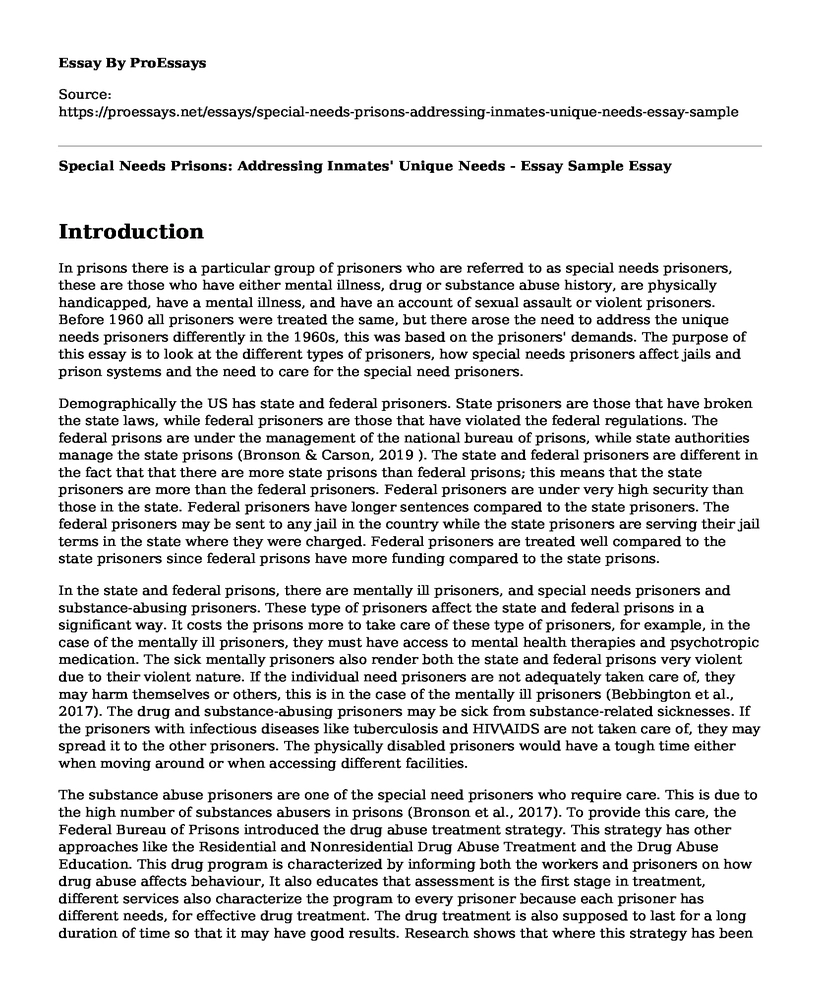Introduction
In prisons there is a particular group of prisoners who are referred to as special needs prisoners, these are those who have either mental illness, drug or substance abuse history, are physically handicapped, have a mental illness, and have an account of sexual assault or violent prisoners. Before 1960 all prisoners were treated the same, but there arose the need to address the unique needs prisoners differently in the 1960s, this was based on the prisoners' demands. The purpose of this essay is to look at the different types of prisoners, how special needs prisoners affect jails and prison systems and the need to care for the special need prisoners.
Demographically the US has state and federal prisoners. State prisoners are those that have broken the state laws, while federal prisoners are those that have violated the federal regulations. The federal prisons are under the management of the national bureau of prisons, while state authorities manage the state prisons (Bronson & Carson, 2019 ). The state and federal prisoners are different in the fact that that there are more state prisons than federal prisons; this means that the state prisoners are more than the federal prisoners. Federal prisoners are under very high security than those in the state. Federal prisoners have longer sentences compared to the state prisoners. The federal prisoners may be sent to any jail in the country while the state prisoners are serving their jail terms in the state where they were charged. Federal prisoners are treated well compared to the state prisoners since federal prisons have more funding compared to the state prisons.
In the state and federal prisons, there are mentally ill prisoners, and special needs prisoners and substance-abusing prisoners. These type of prisoners affect the state and federal prisons in a significant way. It costs the prisons more to take care of these type of prisoners, for example, in the case of the mentally ill prisoners, they must have access to mental health therapies and psychotropic medication. The sick mentally prisoners also render both the state and federal prisons very violent due to their violent nature. If the individual need prisoners are not adequately taken care of, they may harm themselves or others, this is in the case of the mentally ill prisoners (Bebbington et al., 2017). The drug and substance-abusing prisoners may be sick from substance-related sicknesses. If the prisoners with infectious diseases like tuberculosis and HIV\AIDS are not taken care of, they may spread it to the other prisoners. The physically disabled prisoners would have a tough time either when moving around or when accessing different facilities.
The substance abuse prisoners are one of the special need prisoners who require care. This is due to the high number of substances abusers in prisons (Bronson et al., 2017). To provide this care, the Federal Bureau of Prisons introduced the drug abuse treatment strategy. This strategy has other approaches like the Residential and Nonresidential Drug Abuse Treatment and the Drug Abuse Education. This drug program is characterized by informing both the workers and prisoners on how drug abuse affects behaviour, It also educates that assessment is the first stage in treatment, different services also characterize the program to every prisoner because each prisoner has different needs, for effective drug treatment. The drug treatment is also supposed to last for a long duration of time so that it may have good results. Research shows that where this strategy has been well implemented there has been a reduction of mental illness, reduced drug relapse, reduced repeated offences and it has increased inmates adherence to the rules and regulations put in place.
Conclusion
In conclusion, special treatment for prisoners is very important in both the state and federal prisons. This ensures that the prisoners are well treated in prisons and that the prison system is successful in its administration. In the case of drug-abusing inmates, they must be closely monitored to ensure that the treatment benefits them. In cases where the prisoners may be going back to the community, there should be strict regulation that they continue with the program for this treatment to benefit and to ensure that they do not relapse.
References
Bebbington, P., Jakobowitz, S., McKenzie, N., Killaspy, H., Iveson, R., Duffield, G., & Kerr, M. (2017). Assessing needs for psychiatric treatment in prisoners: 1. Prevalence of disorder. Social psychiatry and psychiatric epidemiology, 52(2), 221-229.
Bronson, J., & Carson, E. A. (2019). Prisoners in 2017. Age, 500, 400. https://scholar.googleusercontent.com/scholar?q=cache:ZsmE3r0X9K8J:scholar.google.com/+federal+and+state+prisoners+in+us&hl=en&as_sdt=0,5&as_ylo=2016
Bronson, J., Stroop, J., Zimmer, S., & Berzofsky, M. (2017). Drug use, dependence, and abuse among state prisoners and jail inmates, 2007-2009. Washington, DC: United States Department of Justice, Office of Juvenile Justice and Delinquency Prevention. https://scholar.googleusercontent.com/scholar?q=cache:HF9UHAeteRcJ:scholar.google.com/+A+comparison+of+the+demographics+and+different+types+of+prisoners,+including+the+differences+between+state+and+federal+prisoners&hl=en&as_sdt=0,5&as_ylo=2016
Cite this page
Special Needs Prisons: Addressing Inmates' Unique Needs - Essay Sample. (2023, Apr 24). Retrieved from https://proessays.net/essays/special-needs-prisons-addressing-inmates-unique-needs-essay-sample
If you are the original author of this essay and no longer wish to have it published on the ProEssays website, please click below to request its removal:
- Paper Example on Serial Killing: Jeffrey Dahmer
- Essay on 14th Amendment and Key Court Decisions From 1870-1930
- Reasoning of Tokyo and Nuremburg Tribunal Essay
- Essay on Voting Rights for Felons in Texas
- What Do Member States Do to Come Up With a Robust Criminal Justice System?
- Research Paper on Violence and Brutality on the US-Mexico Borders
- Essay Example on Protecting the US Homeland: The 2002 Emergency Preparedness Act







